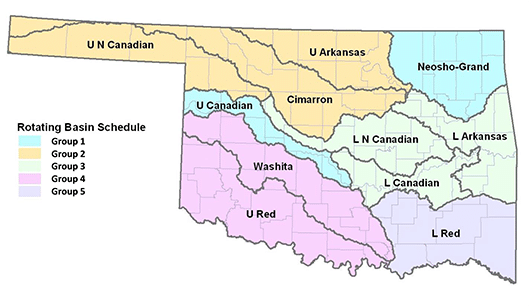Oklahoma is committed to systematically identifying waters impaired by nonpoint source pollution. The Water Quality Division has developed a strategy to monitor small feeder streams on a rotational basis to determine the impacts of non-point source pollution on the water resources of the state. Through the Rotating Basin Monitoring Program, chemical, physical, and biological sampling is done on 250 priority streams in five watershed basins across the state. Each year monitoring begins in one basin, where streams are monitored for two years. Using this rotation, all basins and 250 streams are monitored every five years, and then the rotation begins again. Monitoring is used to:
- Determine the beneficial use status of streams
- Collect information on sources of pollution
- Evaluate success of past and current restoration projects
- Gather data for planning and implementing future projects
Fixed Monitoring Sites
| Group 1 Upper Canadian Neosho-Grand | Group 2 Upper North Canadian Upper Arkansas Cimarron | Group 3 Lower North Canadian Lower Canadian Lower Arkansas | Group 4 Washita Upper Red | Group 5 Lower Red |
| 2001-2002 Report | 2002-2003 Report | 2003-2004 Report | 2004-2005 Report | 2005-2006 Report |
| 2006-2007 Report | 2007-2008 Report | 2008-2009 Report | 2009-2010 Report | 2010-2011 Report |
| 2011-2012 Report | 2012-2013 Report | 2013-2014 Report | 2014-2015 Report | 2015-2016 Report |
| 2016-2017 Report | 2017-2018 Report | 2018-2019 Report | 2019-2020 Report | 2020-2021 Report |
| 2021-2022 Report |

Probabilistic Monitoring Sites
Monitoring randomly selected sites in a basin allows for a statistical statement about the quality of all waters inside the sampled watersheds. To conduct this probabilistic sampling, EPA staff from the Corvalis Lab randomly select for the Commission 150 sites within the basin where sampling will occur the following year. Access permissions are obtained from abutting landowners according to the order of sites listed until a total of fifty sites permissions are obtained. EPA scientists have determined a minimum of fifty sites is necessary to achieve statistical confidence necessary. Water sampling is done and the same parameters measured for the rotating basin streams are assessed. Resulting data are used to make statements with statistical confidence regarding the status of all streams (no greater than Strahler order of 6) from the basin sampled. Data from the probabilistic sites is included in the following Rotating Basin reports: Group 3 2008, Group 3 2009, Group 5 2010, Group 1 2011, and Group 2 2012 (still in progress).